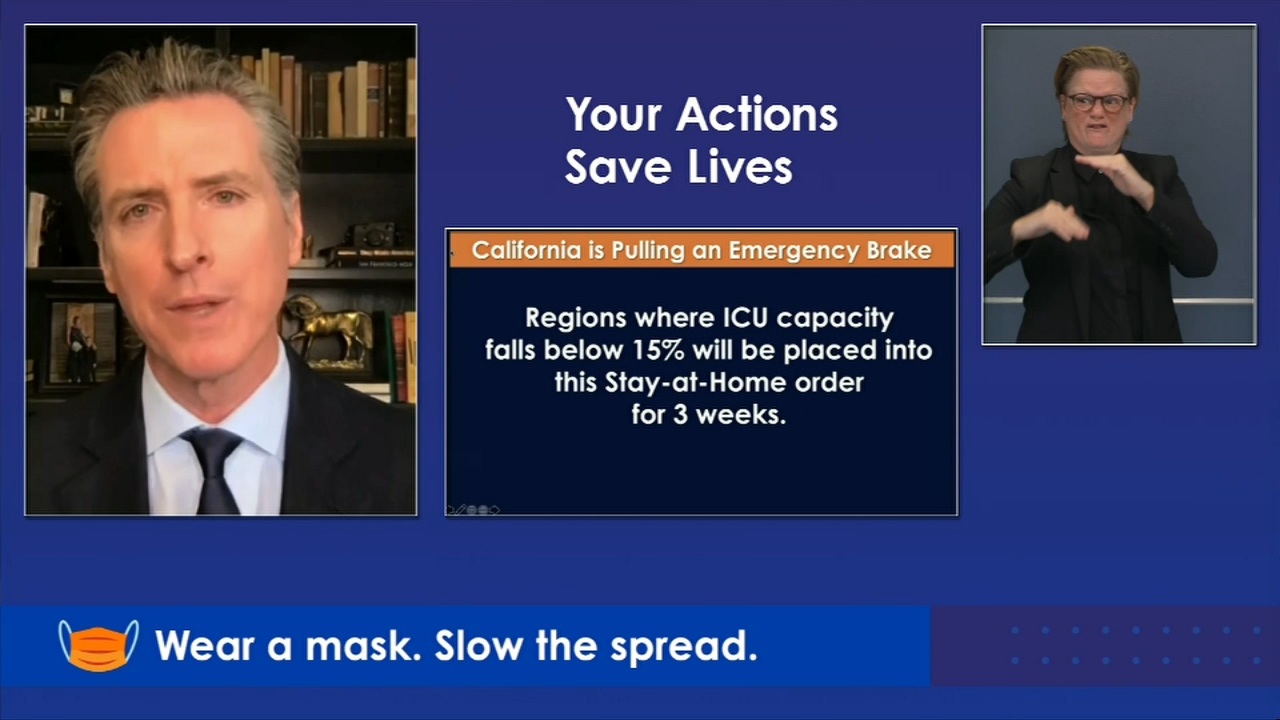Here's how SoCal lockdown will affect you

Gov. Gavin Newsom has announced a strict new region-based stay-at-home order that could take effect in Southern California within days.
The new order will be triggered if a region's hospital ICU capacity drops below 15%.
Newsom said that ICU threshold is expected to be reached "in the next day or two" in Southern California and three other regions out of five in California. The remaining region is the Bay Area and that is expected to hit the threshold later in December.
Once a region hits 15% or lower, the stay-home order will go into effect within 48 hours and will stay in place for at least three weeks, depending on transmission rates and ICU capacity.
Southern California is currently at 20.6% ICU capacity, the state says, but that number fluctuates on a daily basis and many counties continue to report increases in hospitalizations.
The new order again closes a wide range of businesses and activities and urges people to stay at home whenever possible and always wear masks when outside the home.

According to Newsom's office, if a region hits the 15% or lower threshold for ICU capacity, the following activities and sectors must close within 48 hours:
- Indoor and outdoor playgrounds
- Indoor recreational facilities
- Hair salons and barbershops
- Personal care services
- Museums, zoos, and aquariums
- Movie theaters
- Wineries
- Bars, breweries and distilleries
- Family entertainment centers
- Cardrooms and satellite wagering
- Casinos
- Limited services
- Live audience sports
- Amusement parks

"We really all need to step up," Newsom said. "We need to meet this moment head-on and we need to do everything we can to stem the tide, to bend the curve."
Here's where the state's five regions stand:

Once a region drops to the 15% threshold and the order is triggered, that area must stay under the lockdown for at least three weeks. After that, state health officials will evaluate ICU capacity and transmission rates to project at least four weeks into the future to determine if the stay-at-home order can be lifted.
Other sectors will remain open but will face new limits and modifications, in addition to requirements for everyone to wear masks and practice physical distancing:
Outdoor recreational facilities: Allow outdoor operation only without any food, drink or alcohol sales. Additionally, overnight stays at campgrounds will not be permitted.
Retail: Allow indoor operation at 20 percent capacity with entrance metering and no eating or drinking in the stores. Additionally, special hours should be instituted for seniors and others with chronic conditions or compromised immune systems.
Shopping centers: Allow indoor operation at 20 percent capacity with entrance metering and no eating or drinking in the stores. Additionally, special hours should be instituted for seniors and others with chronic conditions or compromised immune systems.
Hotels and lodging: Allow to open for critical infrastructure support only.
Restaurants: Allow only for takeout or pickup.
Offices: Allow remote only except for critical infrastructure sectors where remote working is not possible.
Places of worship: Allow outdoor services only.
Entertainment production including professional sports: Allow operation without live audiences. Additionally, testing protocol and "bubbles" are highly encouraged.
RELATED | Here's how shelter in place can slow coronavirus spread

Other sectors that will be allowed to stay open when operating remotely is not possible include:
- Critical Infrastructure
- Schools that are already open for in-person learning
- Non-urgent medical and dental care
- Child care and pre-K
MORE: Garcetti urges Angelenos to stay home whenever possible











